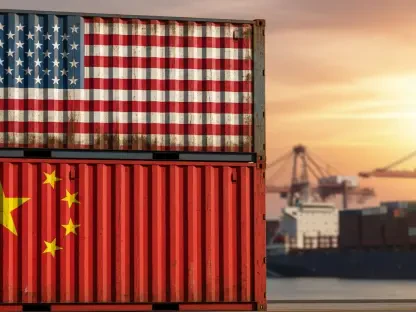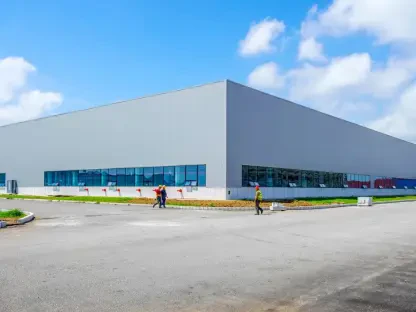Generative AI (GenAI) is transforming the supply chain sector by enhancing traditional AI applications with the ability to create new content based on trained data. This technology is redefining possibilities in supply chain management, driving significant business value through improved interactions, negotiations, product development, and logistics optimization.
Enhancing Knowledge Management and Planning
Transforming Knowledge Management
GenAI is already being explored by about 40% of supply chain organizations for knowledge management. This technology helps classify and categorize information from visual, numerical, or textual data, enabling swift analysis and strategy modification based on real-time insights. By leveraging GenAI, companies can streamline their knowledge management processes, ensuring that critical information is readily accessible and actionable. This rapid analysis and categorization can significantly reduce the time spent on data processing and enable quicker decision-making.
The ability to swiftly modify strategies based on real-time insights means that organizations can remain agile and responsive to changes in market conditions or supply chain disruptions. As a result, they can mitigate risks more effectively and maintain operational continuity. Furthermore, the integration of GenAI in knowledge management facilitates the seamless sharing of information across various departments within the organization, fostering collaboration and enhancing overall efficiency.
Revolutionizing Planning Processes
In planning, GenAI simplifies interactions and enhances decision-making. For instance, a biotech company uses the “chat” function of a GenAI tool to improve demand forecasting by running what-if scenarios and receiving suggestions for various courses of action. This capability is particularly valuable for risk management, allowing supply chain planners to prepare for unforeseen disruptions and maintain operational continuity. The ability to predict and respond to potential issues in advance can save organizations considerable time and resources.
Moreover, GenAI’s role in planning extends beyond demand forecasting. It can also assist in inventory management by predicting stock levels and optimizing reorder points. This ensures that organizations maintain the right balance between meeting customer demand and minimizing excess inventory. Additionally, GenAI can provide insights into optimizing production schedules, taking into account factors such as lead times, production capacities, and workforce availability. This holistic approach to planning can result in more efficient and cost-effective operations, ultimately driving business growth.
Streamlining Sourcing and Vendor Negotiation
Automating Vendor Negotiations
GenAI streamlines sourcing processes by automating vendor negotiations. A US retailer and a European container shipping company utilize GenAI bots to negotiate purchasing terms, reducing costs and timeframes. Notably, about 65% of vendors preferred negotiating with the bot rather than a human counterpart, highlighting the efficiency and effectiveness of this approach. The automation of vendor negotiations not only speeds up the process but also ensures consistency and objectivity in decision-making.
In addition to negotiating terms, GenAI can analyze historical data and market trends to recommend optimal purchasing strategies. This can result in more favorable terms and pricing, further reducing procurement costs. Furthermore, the use of GenAI bots in vendor negotiations allows human resources to focus on more strategic tasks, such as supplier relationship management and long-term planning. By automating repetitive and time-consuming tasks, organizations can achieve greater productivity and operational efficiency.
Enhancing Supplier Relationship Management
Beyond negotiations, GenAI can enhance supplier relationship management by providing actionable recommendations and aiding in contract reviews and renewals. This technology enables organizations to maintain strong relationships with their suppliers, ensuring that procurement processes are efficient and mutually beneficial. GenAI can analyze supplier performance data and recommend strategies to improve collaboration and address potential issues before they escalate.
Additionally, GenAI can assist in identifying new suppliers and evaluating their capabilities, helping organizations diversify their supplier base and reduce dependency on a single source. This can enhance supply chain resilience and reduce the risk of disruptions. Moreover, GenAI’s ability to analyze large volumes of data quickly and accurately allows for more informed decision-making, leading to better outcomes for both the organization and its suppliers. By leveraging GenAI in supplier relationship management, organizations can build more robust and collaborative supply chain networks.
Accelerating Manufacturing and Maintenance
Boosting Productivity and Efficiency
In manufacturing, GenAI accelerates the transition from design to commercialization, even with new materials. Organizations train GenAI models on proprietary data to boost productivity and efficiency. This capability allows companies to bring products to market faster, meeting customer demands and staying ahead of competitors. The use of GenAI in manufacturing can also help identify potential bottlenecks in the production process and suggest ways to optimize workflows.
For instance, GenAI can analyze production data to recommend adjustments in machinery settings or production schedules to improve output and reduce waste. This can lead to significant cost savings and higher overall equipment effectiveness (OEE). Furthermore, GenAI can be used to simulate different production scenarios, allowing organizations to test and refine their processes before implementing changes on the factory floor. This reduces the risk of costly errors and ensures that improvements are made with confidence.
Predictive Maintenance and Equipment Effectiveness
Predictive maintenance is another critical area where GenAI can make a significant impact. By identifying machinery likely to fail, GenAI improves overall equipment effectiveness (OEE). An example cited in the article is a leading industrial manufacturing company in Europe that partnered with a tech leader to implement GenAI for factory automation and product lifecycle management, resulting in reduced product development timelines and higher efficiency. Predictive maintenance not only minimizes downtime but also extends the lifespan of equipment, further driving cost savings.
GenAI can analyze data from various sensors and IoT devices to detect patterns and anomalies that may indicate potential equipment failures. This allows maintenance teams to address issues proactively before they lead to costly breakdowns. Additionally, GenAI can recommend optimal maintenance schedules based on the actual condition of the equipment, rather than relying on fixed intervals. This ensures that maintenance activities are performed when needed, reducing unnecessary downtime and maximizing asset utilization. By leveraging GenAI for predictive maintenance, organizations can maintain high levels of productivity and operational efficiency.
Optimizing Logistics and Operations
Enhancing Warehouse Productivity
For logistics, GenAI optimizes warehouse picking routes, considerably enhancing workforce productivity while lowering operational costs. A major US logistics company employs a proprietary AI platform to achieve these optimizations, customizing GenAI applications to prioritize deliveries, reduce fuel usage, and provide network optimization suggestions. Optimized picking routes reduce the time required to fulfill orders, resulting in faster delivery times and improved customer satisfaction.
In addition to optimizing picking routes, GenAI can assist in inventory management by predicting demand and recommending optimal stock levels. This ensures that warehouses are adequately stocked to meet customer needs without carrying excess inventory. Furthermore, GenAI can analyze data from various sources, such as sales trends and seasonal fluctuations, to anticipate changes in demand and adjust inventory levels accordingly. This proactive approach to inventory management can help prevent stockouts and overstock situations, ultimately improving the efficiency and cost-effectiveness of warehouse operations.
Real-Time Adaptability and Market Responsiveness
This adaptability and real-time optimization help logistics companies remain agile and responsive to dynamic market demands. By leveraging GenAI, organizations can ensure that their logistics operations are efficient, cost-effective, and capable of meeting customer expectations in a rapidly changing environment. Real-time insights from GenAI allow companies to make informed decisions quickly, such as rerouting shipments or adjusting delivery schedules based on current conditions.
Furthermore, GenAI can help logistics companies develop more effective strategies for managing their supply chains. For example, it can analyze historical data and market trends to forecast demand and identify potential risks. This allows organizations to take proactive measures to mitigate these risks and ensure that their supply chains remain resilient. Additionally, GenAI can support the development of more sustainable logistics practices by optimizing routes to reduce fuel consumption and emissions. This not only lowers operational costs but also contributes to environmental sustainability efforts. By embracing GenAI, logistics companies can enhance their competitiveness and drive long-term success.
Addressing Limitations and Risks
Ensuring Data Quality and Integrity
Despite the advantages of GenAI, its effectiveness is contingent on high-quality input data. Data integrity from supply chain partners is crucial for accurate and reliable GenAI outputs. Organizations must prioritize data quality to fully harness the potential of GenAI in their supply chain operations. This involves implementing robust data governance frameworks and ensuring that all stakeholders adhere to best practices for data collection, storage, and sharing.
Regular audits and validations of data sources can help identify and rectify any issues that may compromise data integrity. Additionally, organizations should invest in advanced data management tools and technologies to facilitate seamless integration and real-time updates. By maintaining high standards of data quality, organizations can maximize the accuracy and reliability of their GenAI applications, leading to better decision-making and more effective supply chain management.
Mitigating Ethical and Legal Risks
Reduced human oversight in GenAI applications raises concerns related to transparency, ethics, and legal considerations. Strong governance and collaboration with experienced partners are essential to mitigate these risks. Organizations must establish robust frameworks to ensure that GenAI is used responsibly and ethically. This includes developing clear policies and guidelines for the deployment and use of GenAI, as well as regular monitoring and evaluation of its performance and impact.
Ethical considerations include addressing issues such as bias in AI algorithms and ensuring transparency in decision-making processes. Legal considerations may involve compliance with data protection regulations and establishing accountability for AI-driven actions. By fostering a culture of ethical and responsible AI use, organizations can build trust with stakeholders and minimize potential legal and reputational risks. Engaging with policymakers, industry groups, and other stakeholders can also help shape the development of AI regulations and standards, ensuring that GenAI is used in a manner that benefits society as a whole.
Strategic Roadmap for GenAI Adoption
Focusing on Domain-Wide Transformation
Organizations should focus on generating business value and outline a strategic roadmap for adopting GenAI. This involves identifying high-impact use cases and envisioning a cohesive ecosystem that integrates traditional business models and GenAI-driven innovations. A thorough assessment of the organization’s current capabilities and identification of areas with the most significant potential for GenAI can guide the development of a clear and actionable strategy.
This process should also involve setting measurable goals and milestones to track progress and ensure that the adoption of GenAI aligns with the organization’s broader objectives. By taking a holistic approach to GenAI adoption, organizations can maximize its benefits and drive sustainable growth. Furthermore, integrating GenAI into existing systems and processes requires careful planning and coordination to minimize disruptions and ensure a smooth transition.
Coordinating Organizational Collaboration
Engaging various functions within the organization is crucial to discuss the implications and necessary skills beyond technical roles. By fostering collaboration, companies can ensure that all stakeholders are aligned and prepared for the transformative impact of GenAI. Cross-functional teams can work together to develop and implement GenAI initiatives, leveraging diverse perspectives and expertise to drive innovation and address potential challenges.
Training and upskilling employees are essential to ensure that they have the knowledge and capabilities needed to effectively use and manage GenAI. This may involve providing specialized training programs, workshops, and ongoing support to help employees adapt to new technologies and processes. By fostering a culture of learning and collaboration, organizations can build a workforce that is agile, resilient, and capable of driving GenAI initiatives forward.
Implementing Pilot Initiatives
Launching proof-of-concept projects can help achieve quick wins, understand risks like data quality and hallucinations, and scale GenAI applications. These pilot initiatives provide valuable insights and pave the way for broader GenAI adoption across the organization. By starting with smaller, manageable projects, organizations can test and refine their approaches, identify potential challenges, and develop best practices for scaling up.
Successful pilot projects can also build momentum and support for GenAI initiatives within the organization, demonstrating the tangible benefits and encouraging further investment. Additionally, pilot projects can help organizations develop a deeper understanding of the specific functionalities and limitations of GenAI, allowing them to make more informed decisions about its implementation and use. By taking a phased approach to GenAI adoption, organizations can manage risks more effectively and ensure the successful integration of this transformative technology.
Staying Ahead of the Curve
Generative AI (GenAI) is revolutionizing the supply chain sector by adding a new dimension to traditional AI applications. GenAI can generate new content based on the data it has been trained on. This advancement is setting new benchmarks in supply chain management, significantly enhancing business value. By integrating GenAI, companies are seeing improvements across multiple areas such as interactions, negotiations, product development, and logistics optimization.
With its ability to interpret massive data sets and generate authentic content, GenAI offers more precise forecasts and demand planning. This helps companies maintain optimal inventory levels, reducing both overstock and stockouts. For logistics, GenAI enables better route planning and transportation management, ensuring timely deliveries and reducing costs.
Furthermore, GenAI’s capacity to simulate different scenarios aids in robust risk management and strategic decision-making. By predicting potential disruptions and suggesting alternative strategies, GenAI helps companies stay resilient.
In summary, Generative AI is proving to be a game-changer in supply chain management, unlocking new efficiencies and driving substantial business value through its innovative capabilities.









